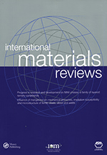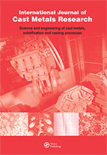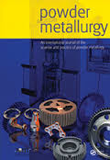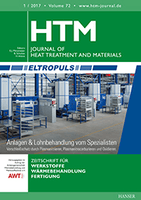
PHYSICS OF METALS AND METALLOGRAPHY
Scope & Guideline
Innovating Insights into Metallography and Materials
Introduction
Aims and Scopes
- Metallic Structures and Microstructures:
The journal emphasizes the study of microstructural features in metals and alloys, including phase transformations, grain boundaries, and the effects of processing on structural integrity. - Mechanical and Physical Properties of Metals:
Research on the mechanical properties such as strength, ductility, hardness, and fatigue resistance of various metallic materials is a core focus, often linked to microstructural changes. - Advanced Material Processing Techniques:
The journal covers innovative methods in material processing, including additive manufacturing, welding, and thermomechanical treatments, aimed at enhancing material performance. - Magnetic and Electrical Properties:
Studies on the magnetic, electrical, and thermal properties of metals and alloys, including investigations into magnetocaloric effects and electronic structures, are significant themes. - Nanostructured and Composite Materials:
Research on nanostructured materials and composites, including their synthesis, characterization, and potential applications, is increasingly featured, reflecting the trend towards advanced materials.
Trending and Emerging
- Additive Manufacturing and 3D Printing of Metals:
There is a notable increase in research related to additive manufacturing techniques, particularly focusing on the properties and applications of 3D-printed metallic components. - Nanomaterials and Nanostructured Alloys:
The study of nanostructured materials, including their synthesis, characterization, and novel properties, has gained significant attention, reflecting a broader trend in materials science. - Magnetocaloric Materials:
Research on magnetocaloric materials and their applications in refrigeration and energy conversion technologies is emerging as a key focus area. - High-Entropy Alloys:
The exploration of high-entropy alloys and their unique properties is increasingly prevalent, indicating a shift towards more complex and versatile materials. - Computational Materials Science:
The integration of computational methods and modeling in materials research is on the rise, facilitating a deeper understanding of structure-property relationships in metals.
Declining or Waning
- Hydrogen Effects on Metals:
Research related to the interaction of hydrogen with metals, which was more prominent in earlier years, appears to be less frequently addressed in recent publications. - Corrosion Studies:
While corrosion remains an important aspect of materials science, specific studies focusing on traditional corrosion mechanisms in metals have decreased, possibly due to a shift towards more innovative protective strategies. - Basic Thermodynamics of Alloys:
Basic studies on the thermodynamic properties of alloys, which were once common, are now less frequently published, suggesting a move towards more application-focused research. - Traditional Ferrous Alloys:
Research specifically focused on conventional ferrous alloys and their properties is declining, as interest shifts towards more advanced and high-performance materials. - Classical Material Testing Methods:
The reliance on classical mechanical testing methods has waned in favor of more sophisticated and interdisciplinary approaches that integrate computational techniques.
Similar Journals

INTERNATIONAL MATERIALS REVIEWS
Your Gateway to Cutting-Edge Materials ReviewsINTERNATIONAL MATERIALS REVIEWS, published by SAGE Publications Inc, is a leading journal dedicated to the comprehensive analysis of contemporary research in the fields of materials chemistry, mechanical engineering, mechanics of materials, and the study of metals and alloys. With an impressive impact factor and a Q1 ranking across multiple categories such as Materials Chemistry and Mechanical Engineering in 2023, it ranks amongst the top journals for innovative materials research. The journal has a long-standing history since its inception in 1987 and continues to serve as a crucial resource for academics and professionals alike. Although it is not open access, it is renowned for its rigorous peer-review process and its commitment to disseminating high-quality materials science research globally. Researchers, students, and industry professionals benefit greatly from the journal's insightful reviews, both for the advancement of theoretical knowledge and practical applications within the fast-evolving materials field.

INTERNATIONAL JOURNAL OF CAST METALS RESEARCH
Advancing the Frontiers of Cast Metals KnowledgeInternational Journal of Cast Metals Research, published by Taylor & Francis Ltd, serves as a premier platform for the dissemination of cutting-edge research in the fields of Mechanical Engineering, Mechanics of Materials, and Metals and Alloys. With a commitment to advancing the understanding of cast metals, this peer-reviewed journal has achieved notable recognition, featuring a 2023 Q2 ranking in its respective categories and ranking 71st in the Materials Science field according to Scopus. Researchers and professionals will find a wealth of valuable insights through rigorous studies and innovative findings, reflecting the journal's goal of facilitating knowledge transfer and addressing contemporary challenges in material science. Furthermore, its accessible publication years from 1996 to 2024 ensure that it not only captures the evolution of technology in cast metals but also stands at the forefront of future developments. Ideal for academics and practitioners alike, the journal aims to foster collaboration and inspire new developments within the discipline.

Obrabotka Metallov-Metal Working and Material Science
Pioneering Research in Metals and AlloysObrabotka Metallov-Metal Working and Material Science is a pivotal journal published by Novosibirsk State Technical University, focusing on the dynamic fields of mechanical engineering, mechanics of materials, and the science of metals and alloys. With ISSN 1994-6309 and E-ISSN 2541-819X, the journal serves as a crucial platform for disseminating research from Russia and around the globe. Currently classified in the Q4 category for Mechanical Engineering and Mechanics of Materials, as well as Q3 for Metals and Alloys, it encompasses a wide range of studies from fundamental research to innovative applications. Despite its relatively recent inception in 2019, the journal has established itself with Scopus rankings that highlight its growing influence—Rank #122 out of 176 in Materials Science and Rank #510 out of 672 in Engineering. This journal aims to foster collaboration among researchers, professionals, and students by featuring original articles, reviews, and technical notes that address contemporary challenges in metal processing and material science. As it continues to evolve through 2024, Obrabotka Metallov remains dedicated to enhancing the understanding and application of materials science, making it a significant resource for those invested in the future of engineering and technology.

POWDER METALLURGY
Leading the Charge in Advanced Materials SciencePOWDER METALLURGY, with ISSN 0032-5899 and E-ISSN 1743-2901, is a prestigious journal published by SAGE Publications Inc, located in the United Kingdom. Founded in 1958, the journal has been a pivotal platform for the dissemination of innovative research and advancements in the fields of ceramics and composites, condensed matter physics, materials chemistry, and the mechanics of materials. With a commendable impact factor and consistently ranked in the second quartile across multiple categories, POWDER METALLURGY is recognized for its rigorous peer-review process and high-quality articles. The journal is an essential resource for researchers, professionals, and students seeking the latest insights and developments in powder metallurgy and allied materials science disciplines. While it does not offer open access options, readers can access a wealth of information that underscores the journal's commitment to serving as a foundational reference in the progressing landscape of materials science and engineering.

Metallography Microstructure and Analysis
Illuminating the Microstructural World of MetalsWelcome to Metallography Microstructure and Analysis, a prominent journal dedicated to the exploration of microstructural properties and their implications in metallic materials. Published by SpringerNature, this journal stands at the forefront of research in the field of materials science, particularly focusing on metals and alloys. With an impressive Q2 ranking in 2023 within its category and a Scopus rank of #72 out of 176, it continues to provide significant contributions to the understanding of metallography, attracting diverse readership among researchers, industry professionals, and students alike. The journal spans a converged period from 2012 to 2024, ensuring it captures the evolving landscape of metallurgical studies. Although it does not currently offer open access, this platform is essential for disseminating high-quality, peer-reviewed research that fosters innovation and development in metallurgical practices.

HTM-Journal of Heat Treatment and Materials
Innovating research in industrial engineering and materials chemistry.HTM-Journal of Heat Treatment and Materials, published by WALTER DE GRUYTER GMBH, serves as a vital platform for the dissemination of research in the fields of Industrial and Manufacturing Engineering, Materials Chemistry, and Metals and Alloys. With an ISSN of 1867-2493 and an E-ISSN of 2194-1831, this peer-reviewed journal focuses on the advancements and methodologies associated with heat treatment processes, materials innovation, and their applications across various industries. Notably recognized in the Q3 category for Industrial and Manufacturing Engineering and Materials Chemistry, as well as Q2 for Metals and Alloys, the journal has garnered significant attention, illustrated by its Scopus rankings, placing it among the scholarly discussions within the field. Although it operates under a closed access model, the journal remains committed to impactful research that influences both academia and industry, ensuring its relevance and importance in shaping future developments in materials science. It is an essential resource for researchers, professionals, and students striving to stay at the forefront of heat treatment and materials research.

Metals
Connecting researchers with cutting-edge findings in metallurgy.Metals is an esteemed open access journal published by MDPI, focusing on the diverse field of metallurgical science and its applications. Since its inception in 2011, the journal has provided a platform for the dissemination of high-quality research regarding the behavior, processing, and properties of metals and alloys. With an E-ISSN of 2075-4701, it has quickly established itself within the scientific community, achieving a remarkable Q1 ranking in the realm of Metals and Alloys and a Q2 rank in general Materials Science as of 2023. The journal is situated in Switzerland and is committed to the principles of open access, ensuring that findings are accessible to a broad audience without subscription barriers. With its notable impact factor and a strong emphasis on innovative research, Metals serves as an essential resource for researchers, professionals, and students seeking to advance their knowledge and understanding in the ever-evolving landscape of metallurgical studies.

POWDER METALLURGY AND METAL CERAMICS
Exploring Breakthroughs in Metal CeramicsPOWDER METALLURGY AND METAL CERAMICS is a prestigious journal published by Springer, dedicated to advancing the field of powder metallurgy and the development of metal ceramics. With an ISSN of 1068-1302 and an E-ISSN of 1573-9066, this journal includes significant research contributions that explore innovative developments in materials science and engineering. Since its inception in 1993, it has garnered attention within multiple disciplines, consistently ranking in the Q2 and Q3 quartiles across categories such as Metals and Alloys, Ceramics and Composites, and Mechanics of Materials. The journal offers valuable insights into the synthesis, characterization, and applications of advanced materials, making it an essential platform for researchers, professionals, and students aiming to stay at the forefront of technological advancements in this dynamic field. Although not currently offering open access, the journal remains a critical resource for disseminating high-quality research that influences both academia and industry.

Russian Journal of Non-Ferrous Metals
Shaping the Future of Materials ScienceThe Russian Journal of Non-Ferrous Metals, published by PLEIADES PUBLISHING INC, serves as a vital resource for researchers and professionals in the fields of materials science and engineering. With a dual ISSN (1067-8212 for print and 1934-970X for online), this journal has been instrumental in disseminating cutting-edge research from 2007 to 2023. Specializing in the mechanics of materials, metals and alloys, and the study of surfaces, coatings, and films, it provides invaluable insights into the latest advancements and applications in these areas. Although currently categorized in the Q4 tier for mechanics of materials and surfaces, and Q3 for metals and alloys in the 2023 rankings, its commitment to quality research is reflected in its Scopus metrics, ranking it within the competitive spectrum of its fields. While not an open access journal, it remains a crucial academic platform for fostering knowledge exchange among professionals and scholars. By publishing high-quality articles, the Russian Journal of Non-Ferrous Metals contributes significantly to the ongoing dialogue in metallurgical science and engineering.

METALS AND MATERIALS INTERNATIONAL
Pioneering research at the intersection of science and engineering.METALS AND MATERIALS INTERNATIONAL, published by the Korean Institute of Metals and Materials, is a prestigious journal dedicated to the advancement of research in the fields of materials science and engineering. With an ISSN of 1598-9623 and a robust e-ISSN of 2005-4149, this journal has established itself as a crucial platform for disseminating innovative findings and key advancements that span condensed matter physics, materials chemistry, mechanics of materials, and the technology of metals and alloys. Its Q1 rankings in multiple categories attest to its high impact and relevance in the academic community, placing it among the top journals in its fields with Scopus rankings that reflect a strong international footprint. Here, researchers, professionals, and students can access cutting-edge research and insights, fostering collaboration and exploration of new materials and their applications. With a commitment to excellence and a convergence of knowledge from 1996 to 2024, METALS AND MATERIALS INTERNATIONAL continues to enhance our understanding of materials and their transformative impact on technology and engineering.